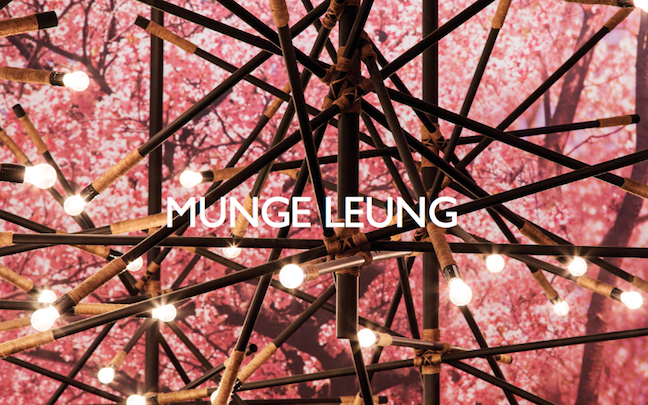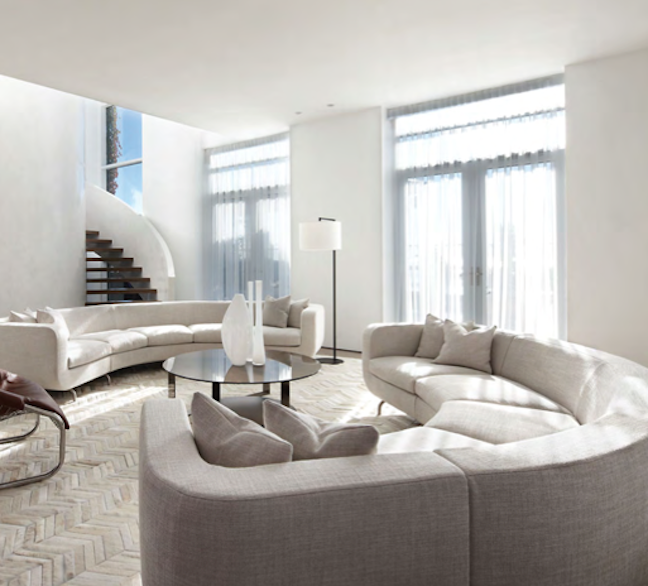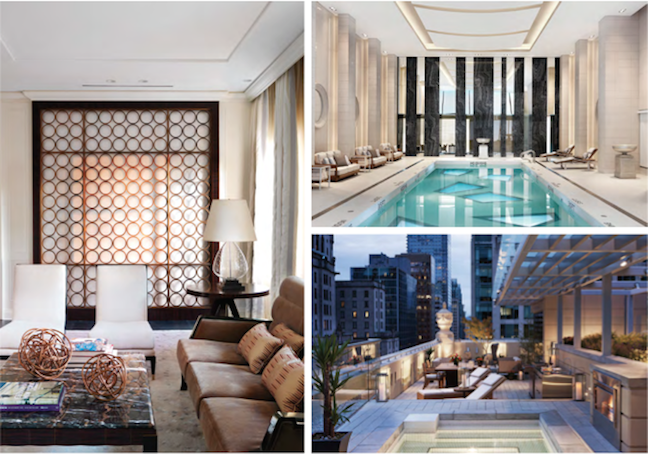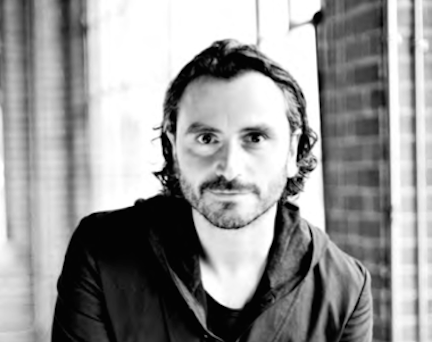Munge Leung (Now STUDIO MUNGE) started in 1997 by Alessandro Munge, Managing Partner and Sai Leung, Design Director – after Alessandro realized it was time to step out on his own. Starting from the dining room table of Alessandro’s then-girlfriend (now wife), the dynamic duo has grown into an Internationally recognized and Toronto-based, interior design firm creating the interiors for a global client list that includes luxury hotels to iconic restaurants. The rise and rise of the Studio Munge brand is a testament to sticking to your vision, as the team just recently moved into a 12,000 sq. feet of- fice in the Toronto area. Not bad for a firm that started with an idea and a simple dining room table.
Interview with Alessandro Munge
It’s a cold Friday afternoon in Montreal, on a greyish March day. The kind of day that even though it’s T. G. I. F., still the lingering question remains: “Why are we still living in an ice box!” I am now on hold waiting for one half of by far one of the hottest design firms in Toronto. I think it fair to say that gener- ally readers are very simpatico with the interviewee, but rarely do we think of the one doing the interview. Well, for the record this interviewer is totally adverse to phone calls; so much so, that he does not even own a (gasp) cellular phone. So old school is he, that he is presently looking for a rotary black (gifts welcomed). Back to the interview.
At “hello” I am soothed by Alessandro’s vibe, (there is no won- der Munge Leung has over the last 15 years, emerged as one of the best in not only North America, but the world) he knows just how to communicate with passion and emotion.
The style of this interview is simple, allow me to bring you into the phone call.
I have to tell you, its a real honor to be speaking to you on the phone – we really love the work you guys are doing. When I first saw a Munge Leung space, the details seem to morph and change as I observed them; you almost get the feeling that your spaces are breathing.
I will never get used to people complimenting our work because it just doesn’t seem like work to me. It’s like we keep getting these gifts where likeminded clients will say to us, are you interested in designing a restaurant for me? Or a hotel for me? It just fits. The older and older we’re getting in our firm, the more status we’re getting. The easier and easier it’s becom- ing and it is just a pleasure. I wish I could tell you that there’s a project on our list that I’m just not enjoying. And I’m glad to hear what you’re saying, because we do stress over those details that you see on our website and if you visited any of our projects or if you slept in them or had sex in them or whatever it is. And I don’t mean they’ve had great sex only in our hotels. I’m talking people are having sex in our restaurants and I’m thinking what are we doing? Something is right!
It’s funny because what I’ve found with your projects is that there is always hidden surprises that will reveal themselves in a way that almost has a sexual context. The longer you stay there, the more it gets revealed.
I wish you and I were face-to-face for this interview because it would just be really awesome. I thrive on expressions and people in general. I just study people too much. I just study peoples’ emotions and what they’re doing in a room and how they react and that is what really drove me into this business. Quite frankly, I just love seeing the reactions of people. And what you’re talking about is that reaction – an emotional reaction. And I have to tell you about how we have done an exercise where people have gone out to interview our clients and interviewed people in our spaces and things and people consistently say the same things. That there is an emotional attachment when you’re in our spaces, that you wouldn’t necessarily capture in our photography. I know that if I give you a list of photographers, ten will probably tell you that we drive them crazy because we keep saying that we don’t capture the space. And that’s because it is very difficult to capture the emotion in the light. You can capture the people. And that’s exactly the thing. We’re almost rethinking our portfolio. It really isn’t about the pretty pictures of the spaces only; it’s really about people and seeing their reaction. I often sit in a bar in a corner and I’ll sit and just watch peoples’ reactions. People act differently in each one of those spaces because of the feeling and the emotion of the space and the textures. This is what really gets into peoples’ sensory.
I like that you create from paper in your offices and it becomes a living breathing space, that’s really cool!
I think so, if you think about when a project starts. We constantly force our designers to get their hands off the keyboard and off the mouse and onto tracing paper. I think that when people are drawing and sketching with their hands, I find that that process is really innate. Nobody comes to a meeting at one of our tables without tracing paper, the right pens and the right colors. They just wouldn’t do that, because every stroke that we put down is a different emotion.
I travel quite a bit. I think the worst part about travelling is probably two-fold. One is I miss my family. I have kids and it’s very difficult to be away from them but they are so understanding it’s incredible. In the airports when I travel everybody is lonely there are gangs and gangs of people, nobody is smiling, everybody is stressed out of their minds. It’s a lonely place and I find a very lonely experience. But the blessed part about it is when the plane lands and you’re in a new city. Where the hell do you get an opportunity to see the world like this? You don’t and you cannot see it from your chair at your desk. It’s impossible to see design in your table on your desk in a two thousand square feet office. It’s just not possible!
How did you and Sai meet?
We used to work at a firm and at the time he was actually my senior and I came into the firm as a junior. We kind of worked paired together there and we got to work on the best projects. But we always knew in our hearts that we would leave and want to do our own thing. I always told to myself that I wasn’t a very good employee; I was never good at people telling me what to do. Even though we had freedom beyond there I was probably better at employing rather than being the employee. I liked the freedom and the concept of being able to come from nothing. We started drawing on the dining room table with my wife, we had nothing to us and then we landed our first project. We hadn’t created this strategy where we were going to create this thing. I just woke up one morning from staying up until 3AM to designing away. I just thought, “well I think tomorrow morning, I’m going to leave. I have no idea why, but I’m going to leave”. It is crazy but I think that defines us. He wanted to join me and I said no, we have no money. So we just took a chance at life and the rest is history. I really admire him and see him as someone who has a lot of faith in what we do. We are very black and white, if he were here, he would just say a few powerful words while I’m here being Italian and very emotional. You can see a bit of that in our work. This is why everything we do can be just as calm and bold and then do something crazy. You can really just put yourself in the moment. Where we want people to be calm, we design it that way and can predict how people are going to react to this environment. Different feelings like touching the menu or walking out the front door. What does that human being feel like when they are standing in front of our building? It is a journey through the space. We don’t want people to say Wow! And then its done, it has to have discoveries. So that next time you come you see something and realized that you missed something.
A unique hotel in Sao Paolo curved the floor in the rooms up around the perimeter. You know when you go skate- boarding? The floors are curved up as in a skateboard park. It is like an Alice in Wonderland feeling. In the con- text of what you do, you can give that without having to curve the floors. Does it go back to that emotional experience again?
Sure! I think it has a lot to do with our power. Our library is probably about 20% of the size of the office and the pressure that our studio feels whenever we do a project is this. We just did this Italian restaurant, it was published and everyone loved it, now another client comes in with the same idea. They really loved that restaurant they want to redo the Italian restaurant. So, I want you to take all the elevations and the drawings for that restaurant and store them in the garbage. Forget about it, we will not repeat it, it’s gone! We then need to reinvent our- selves for a new Italian restaurant. We push it all the time, we want to challenge ourselves. We’re not here to repeat, were here to define. Back to your question, I think it had a lot to do with how we layer our interiors. If I was in fashion, I would put in a lot of layers, I love the texture of the fabrics. It makes that moment right for us in our hearts.
How do you maintain the integrity of the Studio Munge vibe throughout all your projects – at the same they are all entirely different.
We have partners who will come in and do graphic design for us, but we prefer to have control. We want to be able to walk them through our images of inspiration and the stories that came with it. So that when you, the guest, come into our spaces, there’s no missing something here. When I do a restaurant, I want to know the cook and what he is cooking and how they cook and what their vision is. The reason you’re there is the food, so if we control the environment around the food and it works, then that is going to be a beautiful experience for you. You have to understand everything around you to create space. And that’s why we can truly say that each of our projects is different. I wouldn’t do a project in Toronto like I would in Dubai. Our work in China is different from anywhere else, because people are different. The world is changing so fast and everything is so disposable so you have to make sure that everything that you do is unique. You can dispose of your phone, but you can’t dispose of an interior. That’s probably why a project like Hotel Georgia for us in Vancouver, it would’ve been easy for us to juxtapose the interior there with a modern space with the old space. But we were looking to keep the classic in there. We studied the city and know that everything is modern and made of glass there is all similar and brand new. So Hotel Georgia was a big difference. We spent a lot of money restoring it, and then we added a few objects of what is new today with luxury. Talk about a project that pushes on the sensory of emotion. The hotel is now sending feedback from Trip Advisor where people are speaking and that’s a win for me.
We were pretty lucky that we had an amazing client, Charles, he came to us and told us he wanted to renovate the Government nightclub. So we put forward a design where, we had just come out of where we were doing all these beautiful luxurious projects and had no sense of budget and things like that. So when we attacked it with flashes of color and I remember going to the club every Saturday to see and study what was going on there. So at that time we had really done something that pushes the envelopes of the designs. And it was from there where any firm would know, that your projects get better and better and more and more budget, its only then when the next client will trust you with their bigger projects. You can’t start with a 1,200 room hotel in New York City, unless you’re well connected.
Tell me about your city and give me three places in Toronto that you really like. It’s a city guide right?
I’m so happy here. You have to own it and be passionate. You have to be passionate to come to office and be in this business. You have to be everywhere. For Toronto, what’s cool about it, is that it started to create itself as districts. Maybe similar to New York in that respect, but in no where near where New York is so dense and vibrant because of its density. Where Toronto is starting to come into the small pockets, like we were talking about how King Street today is a happening spot today. And there are many different places where restaurants are popping out. You can escape and do the Toronto scene. There is diversity and you can do 4 blocks and really get something different. It’s not just about selling, but they have a responsibility of creating a community for people. Would it make the magazines? No!
Who are you?
Who am I?! Wow! A kid in a candy store. There’s so much that inspires me all the time. I feel like a kid in a candy store and like the luckiest man in the world. I’m just an excited guy.






